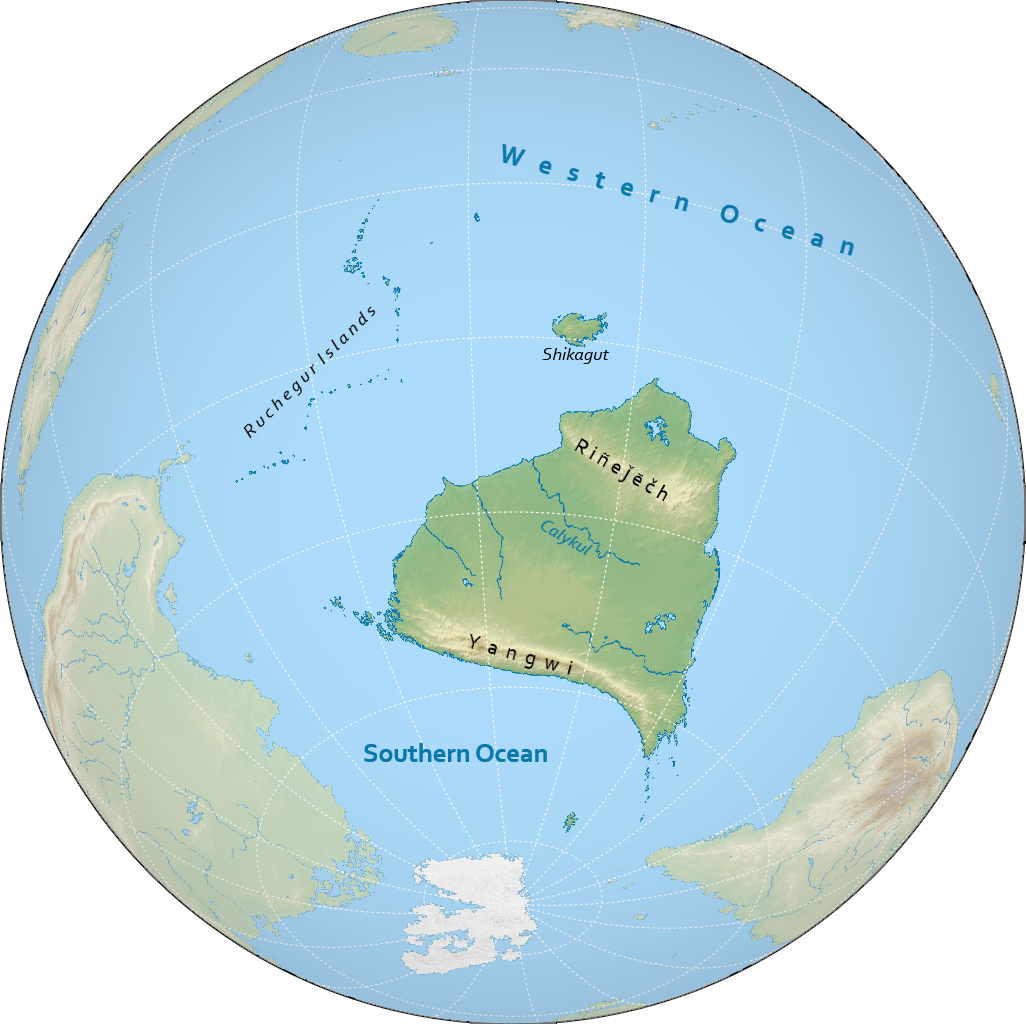name
the name gonavi is a combination of the namak term 'kōnafk' meaning south, and the waptokan suffix '-yi' meaning land, owing to its southerly location relative to north emiheg.
geography
gonavi is the smallest continent on notasami at 12 million square kilometres. the continent is mostly surrounded by the western ocean, to the north, and the southern ocean on the southern coast.
climate
the climate of gonavi is mostly temperate.
the north of gonavi is arid, save for some temperate and mediterranean areas along the eastern coast and the riñeǰēčh mountains.
the south is temperate, with a more subarctic interior.
the southern coast is defined by the yangwi mountain range, which add both more alpine climates and more arid climates on the coast.
countries & territories
| flag | name | population | area |
|---|---|---|---|
| west gonavi | 126,424,774 | 2,205,793 km² | |
| (tbd) | - | - |
history
the history of gonavi is usually divided into the following periods:
- prehistory: before -2500
- bronze age: -2500 to 50
- classical period: 50 to 250
- postclassical period: 250 to 1250
- šikagi era: 1250 to 1900
- colonial period: 1900 to 2050
- modern period: 2050 to 2300
- interstellar period: 2300 to present
agriculture on gonavi seems to have evolved in the southwest initially, spreading northwards and then diffusing across the continent. otherwise, most prehistoric societies are thought to have been nomadic.
this age is known primarily for the calykul river civilisation, one of the earliest civilisations on notasami. it collapsed after roughly a millenium, and it would not be rivalled by any other polity for yet another millenium.
this brief period sees much of the continent rules by a small number of kingdoms which proved to be foundational to much of the culture of gonavi.
the classical kingdoms of gonavi eventually broke down and fractured into several squabbling polities for another thousand years. though instability is rampant, many places backslided, and no clear regional power ever really forms for long, a common trait among many of these states is an emphasis on preserving the traditions established by the classical kingdoms
this era for the most part continues the trend of the previous period, but special attention should be paid to the šikagi, who emerged around 1250, and would lead the continent in matters of commerce. through their trading they managed to make contact with rundanuyi, and according to some accounts, reached as far as south emiheg. they settled the ruchegur island chain, set up several trading posts and occasionally whole states along the northern shore of gonavi, and eventually, due to contact from rundanuyi, adopted terenism, which they spread across the north of gonavi. challenging established tradition and religion, some polities responded with hostility, while others were more open to the new flow of ideas and culture, and quickly followed the šikagi in adopting at least some of these new traditions.
this period sees much of gonavi dominated under powers from emiheg, namely gutonim and bizoyi. the šikagi however remained the regional power in the north.
this age sees the colonies of gonavi gain independence from the empires of emiheg, some through struggle, and some peacefully.
this recently-defined period starts with the discovery of interstellar travel and examines the role of the countries of gonavi in the now accessible interstellar domain.
demographics
languages
there are four main language families in gonavi: the southern gonavi languages, the nulukan languages in the west, the zemeczan languages in the southeast, and the nodancian languages in the northeast. šikagi can be either be considered a language isolate or its own small family, depending on how one wishes to classify its dialects. there are numerous other smaller families and isolates, and it is estimated that there are around 165 languages spoken on gonavi. anacek, bizom, and šikagi are also very common second languages, particularly in the west, east, and north, respectively.
religion
three main native religions can be found in gonavi. šedeten is practiced in the eastern half of the continent, exakwan along the northwest coast, and kilcig in the south. apart from this, terenism is the dominant faith in the ruchegur islands and šikagut, and is also common in the north of the continent. bunapunism is also fairly present, mainly kekataki and southern bunapunism.
population
the most populous country in gonavi is east gonavi with over 125 million people, and is the only one on gonavi that has a population of more than 100 million people. most countries in gonavi have populations over 1 million people, and four countries have more than 10 million people.
the largest metropolitan areas in gonavi include kigdey and šedetenzecit. the two of these have populations exceeding 5 million people, and four more have more than 2 million people.
